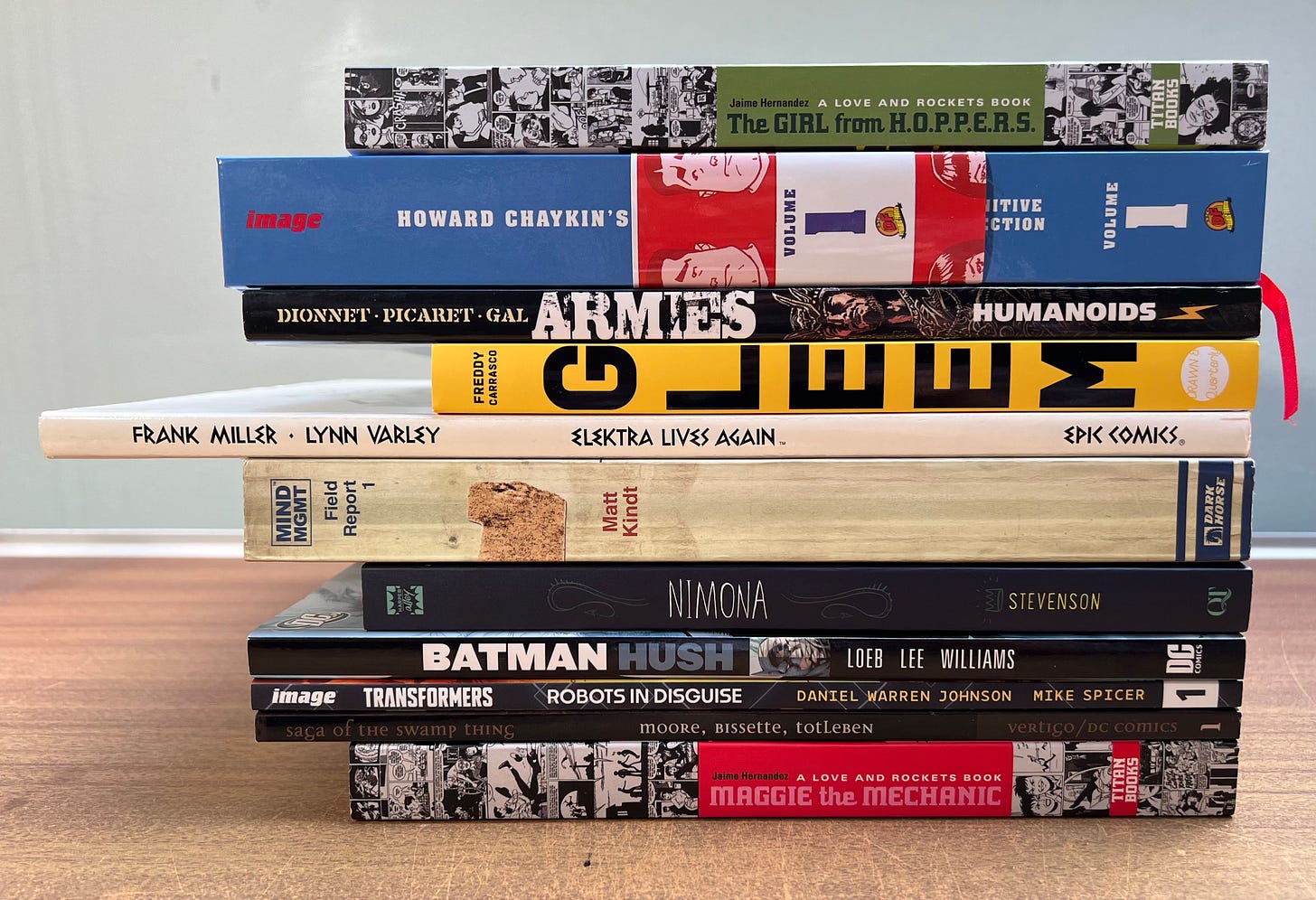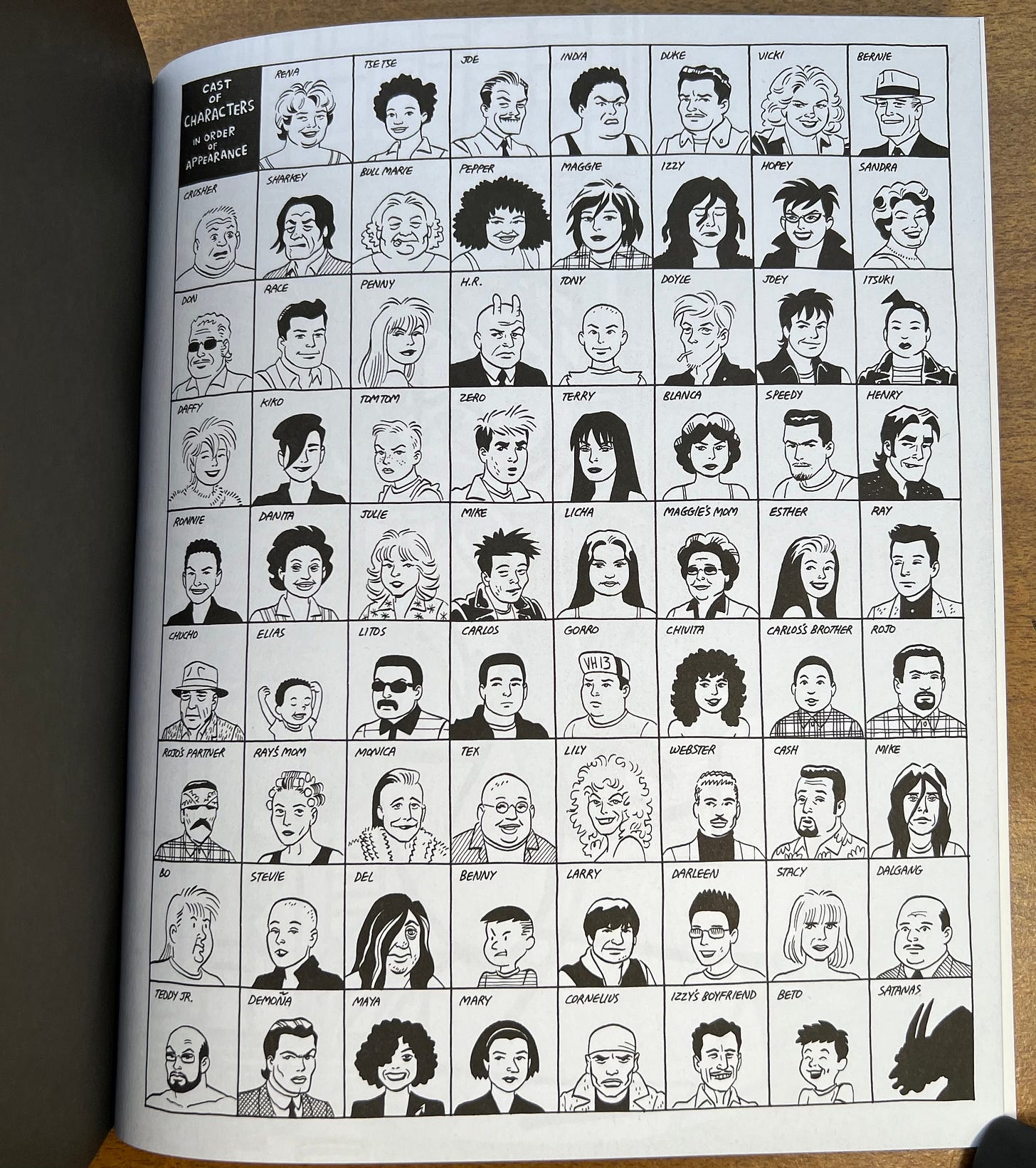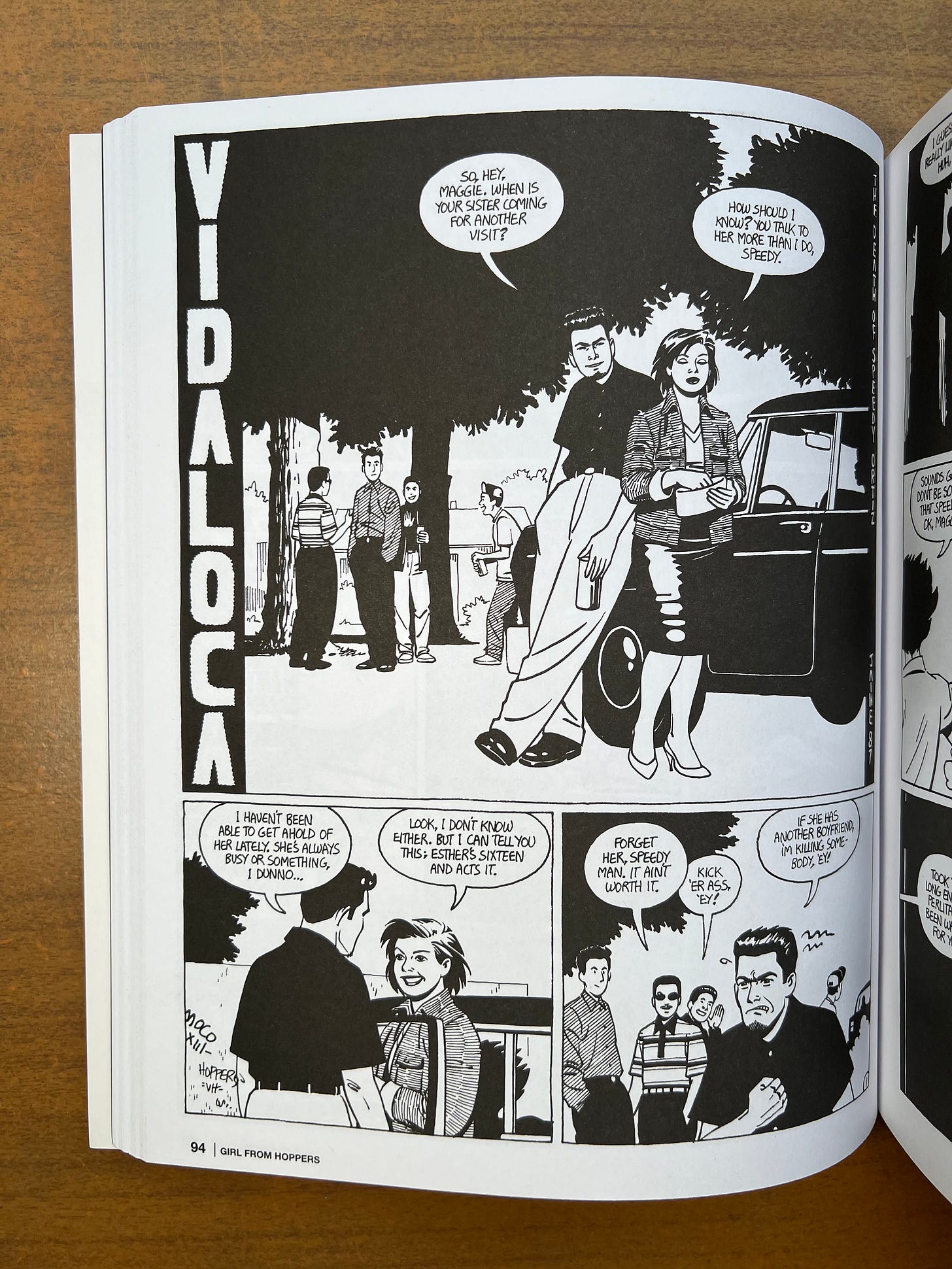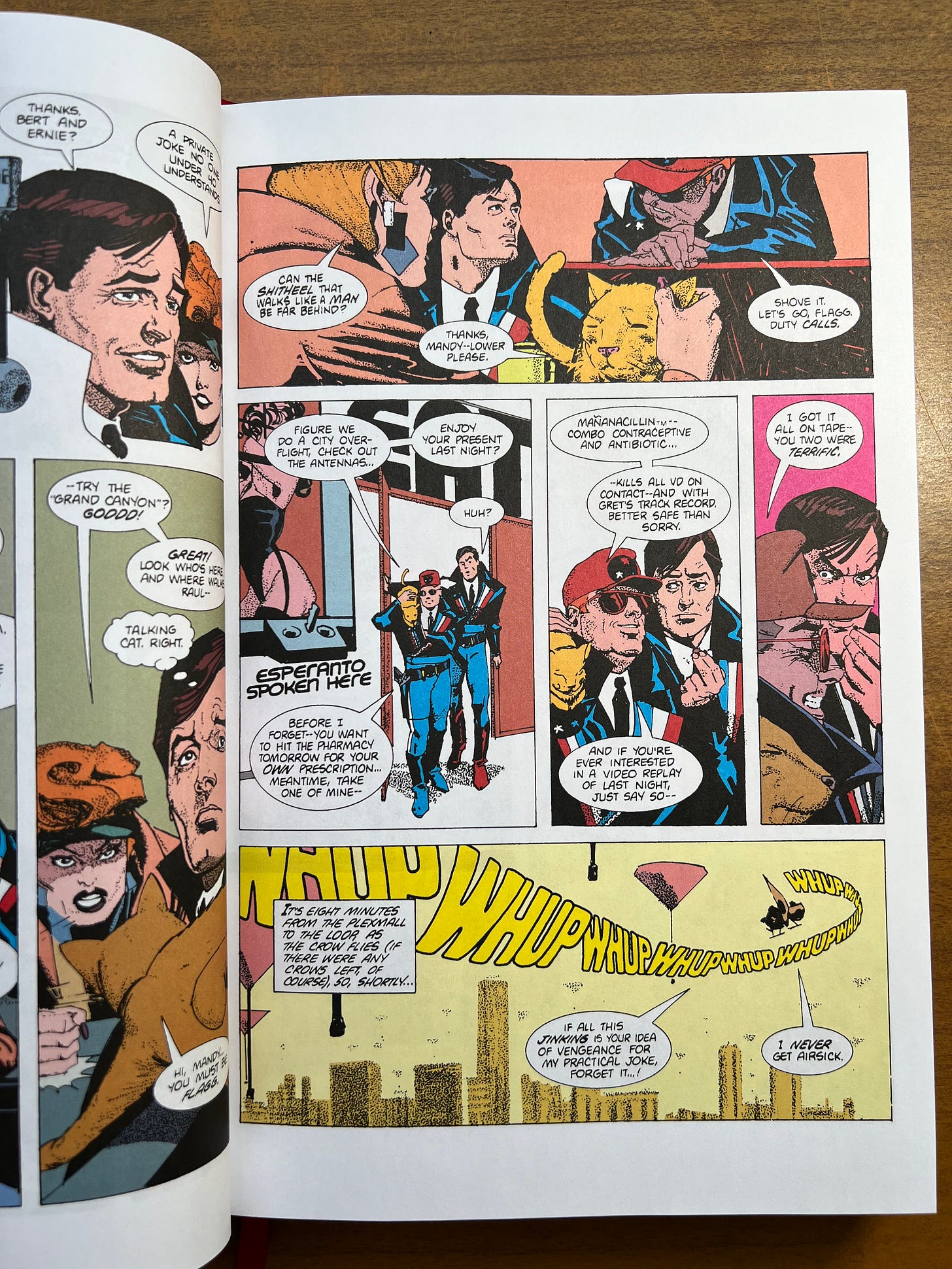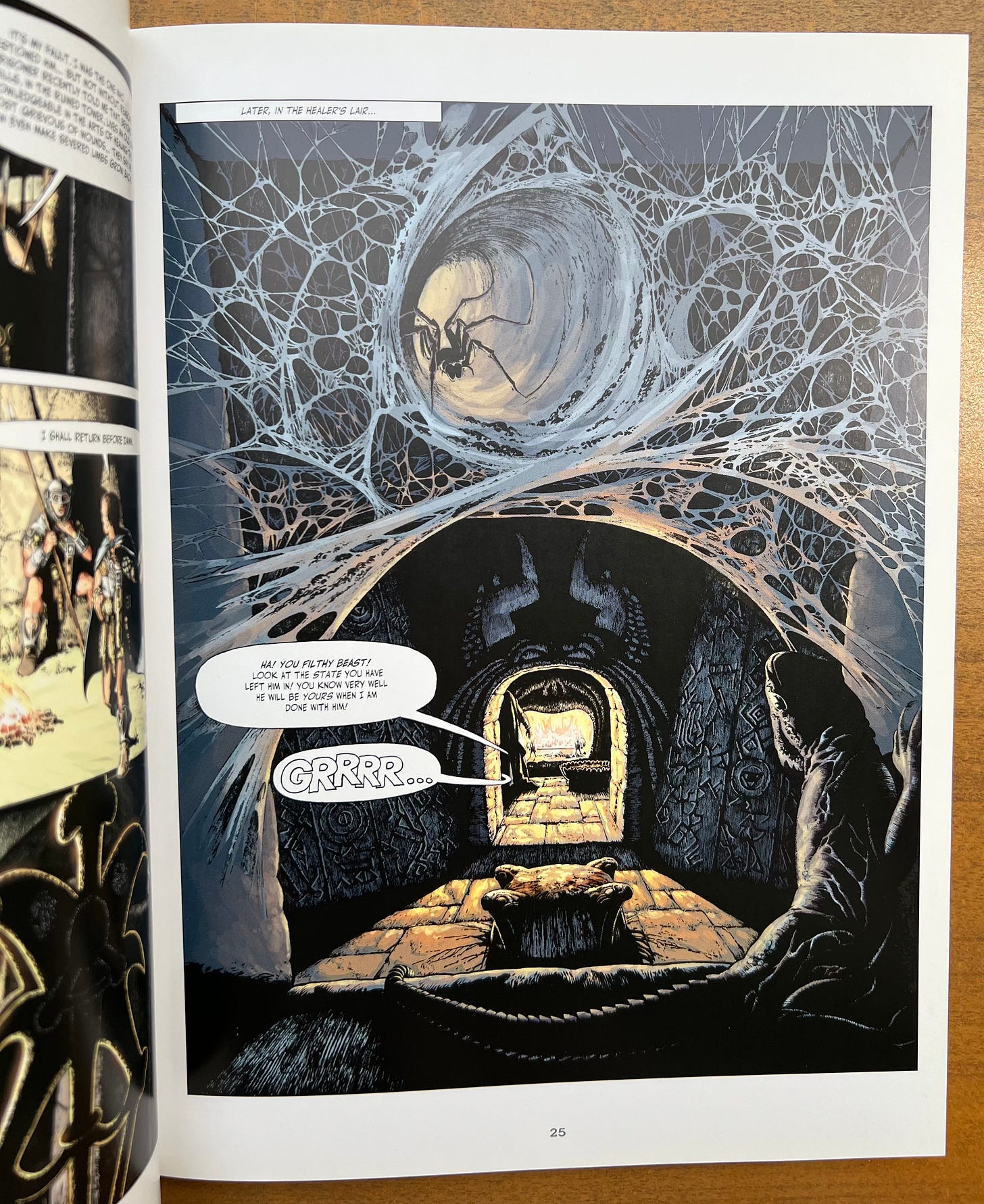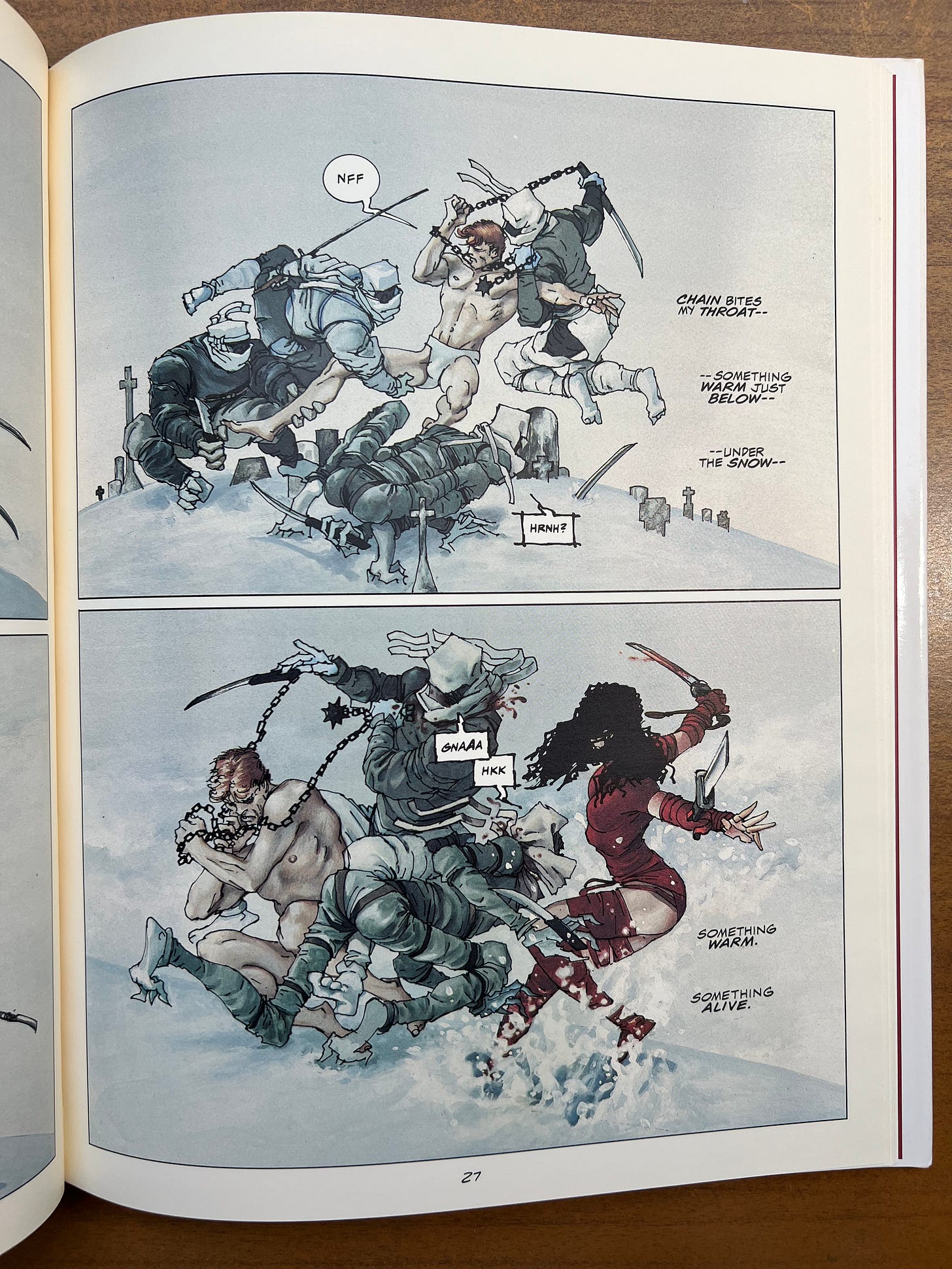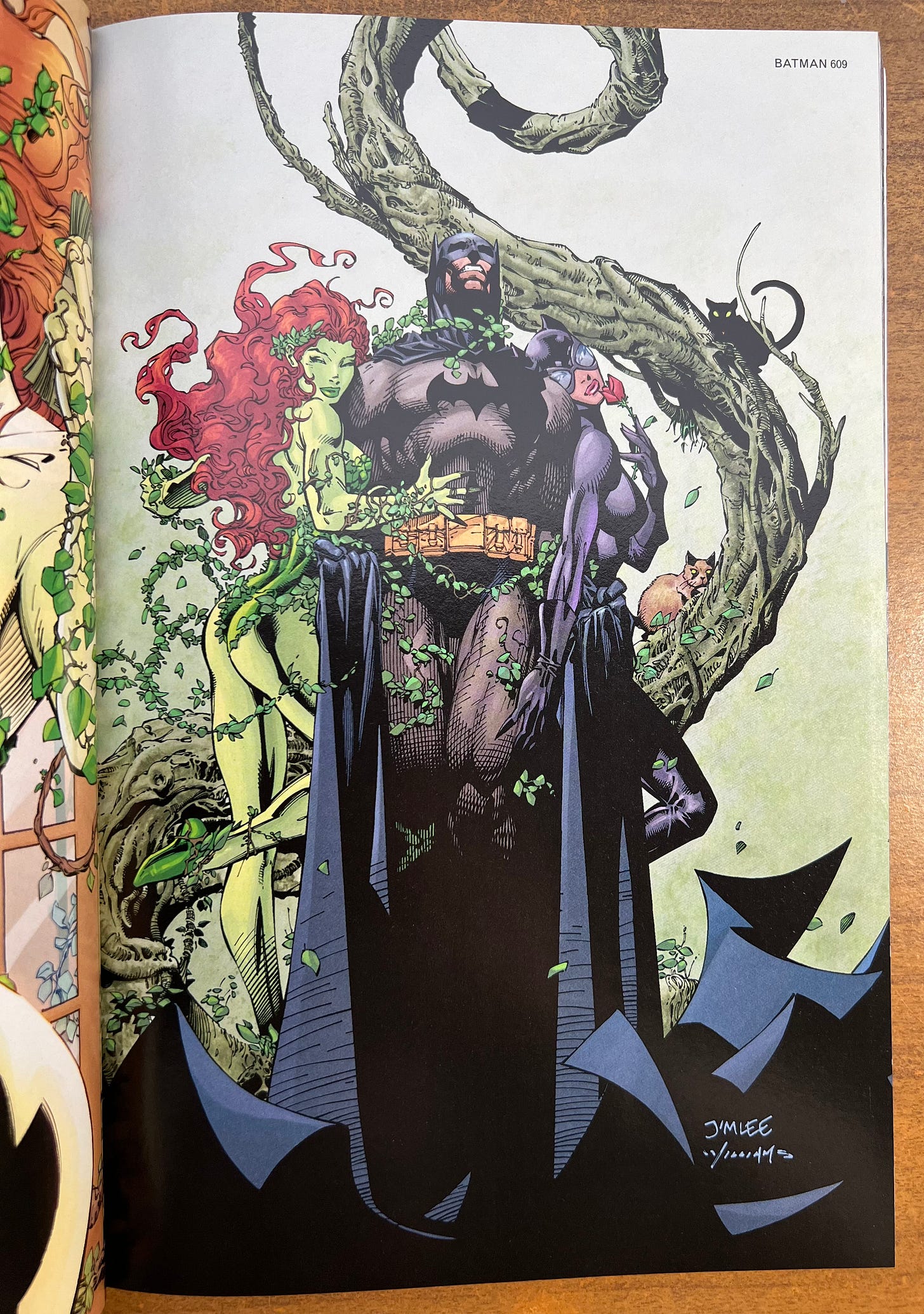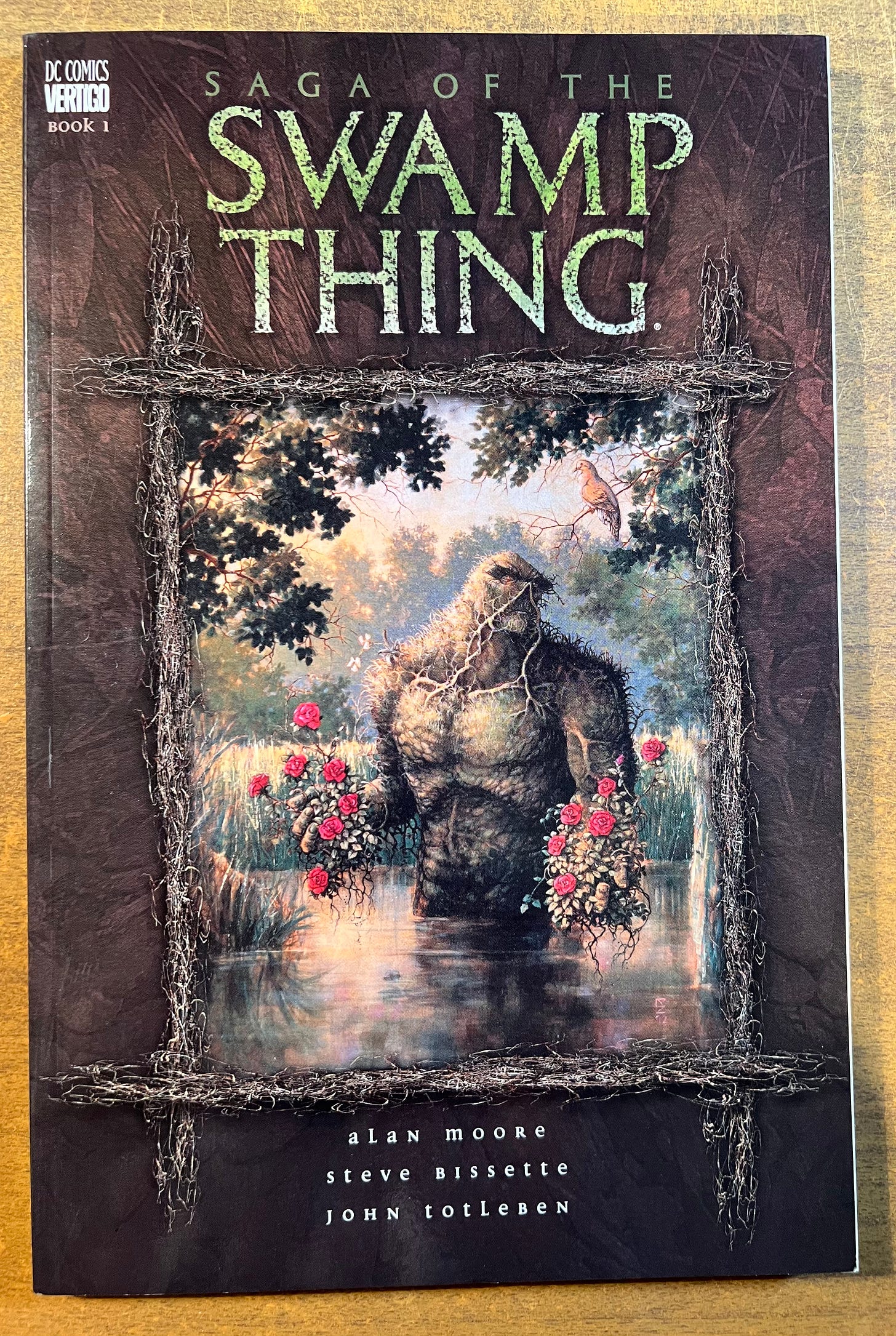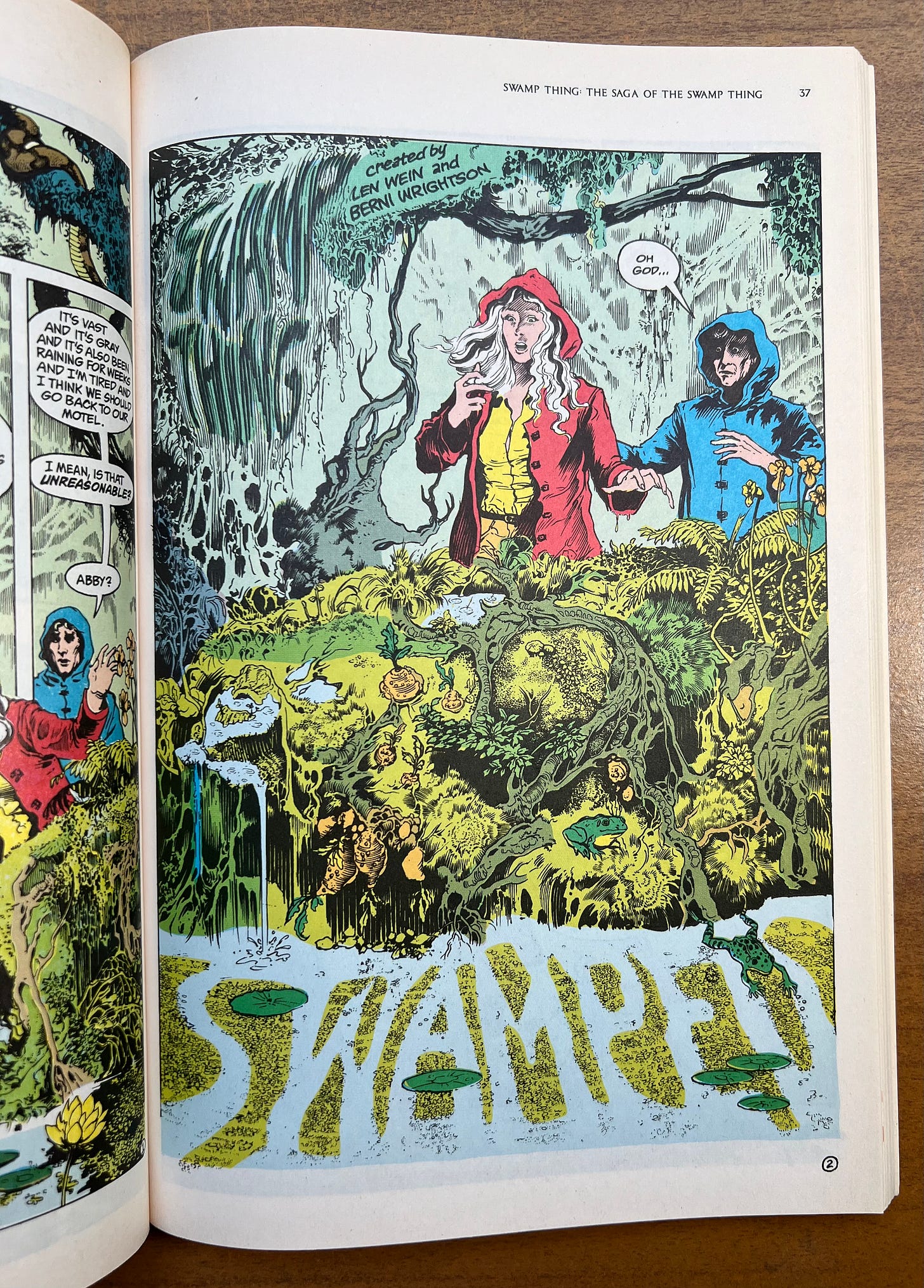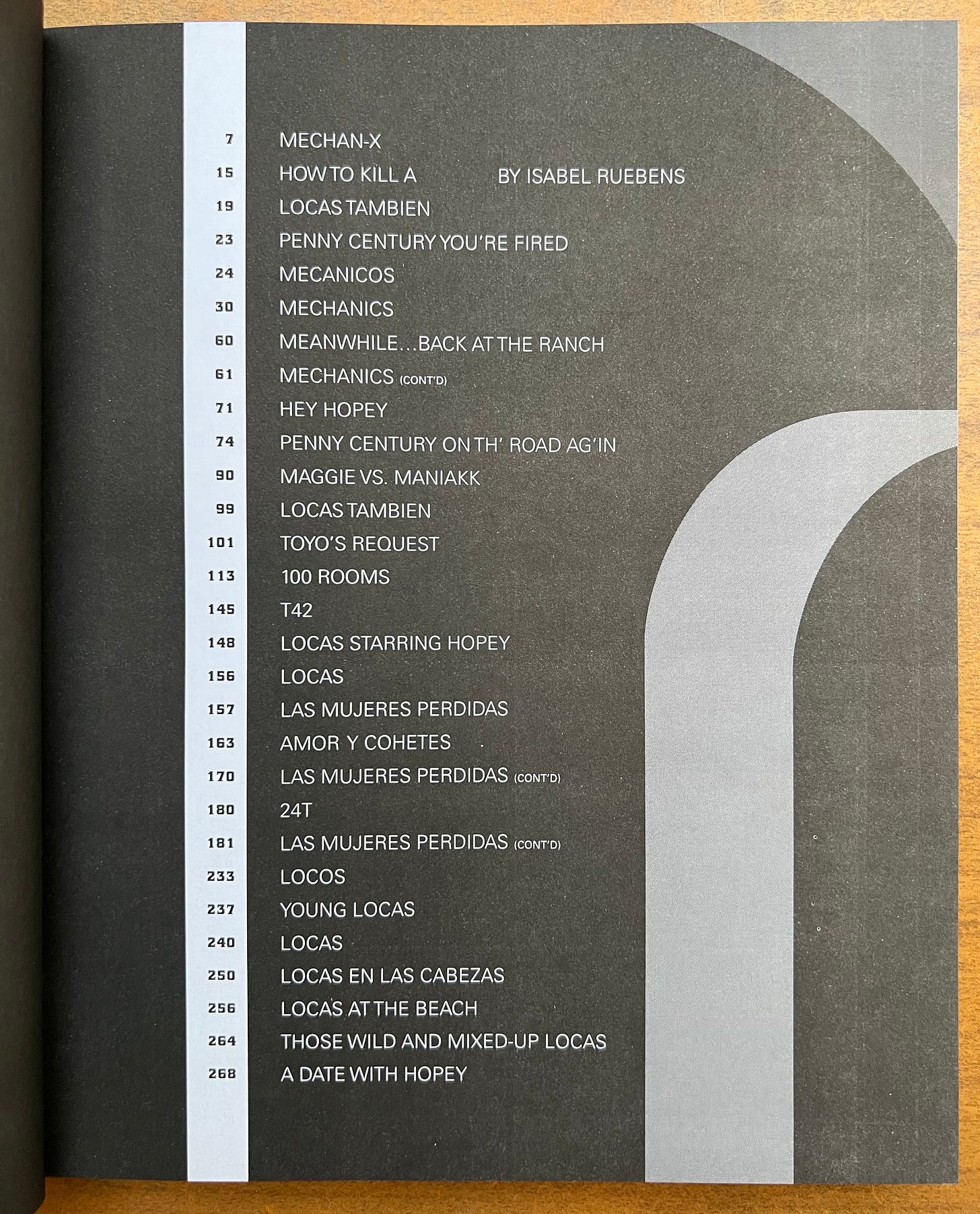Review of Comics read in January 2025
This was inspired by the monthly Top 10 thread on the graphicnovels subreddit.
Since the idea is that each month the top 10 list may be updated with new favourites, I decided that as well as tracking my reading and writing down my impressions, I needed my own numerical ranking system. I am trying this out now, but it is not set in stone yet.
I have tried to avoid any big spoilers, but some degree of spoilerage may be inevitable.
Contents:
The Girl from H.O.P.P.E.R.S. by Jaime Hernandez 10/10
American Flagg the Definitive Collection vol 1 by Howard Chaykin 8/10
Armies by Jean-Pierre Dionnet, Picaret and Jean-Claude Gal 8/10
Gleem by Freddy Carrasco 8/10
Elektra Lives Again by Frank Miller and Lynn Varley 8/10
MIND MGMT Field Report vol 1 by Matt Kindt 7/10
Nimona by ND Stevenson 7/10
Batman: Hush by Jeph Loeb, Jim Lee and Scott Williams 7/10
Transformers: Robots in Disguise by Daniel Warren Johnson and Mike Spicer 7/10
Saga of the Swamp Thing vol 1 by Alan Moore, Stephen Bisette and John Totleben and Maggie the Mechanic by Jaime Hernandez (tie) 6/10
1. The Girl from H.O.P.P.E.R.S. by Jaime Hernandez
I’ve had this and Maggie the Mechanic (see the review below) sitting on my shelf for about fifteen years. I was utterly blown away when I finally read this over the Christmas break (hence this made it into my Top 10 Comics read in 2024 list on reddit too).
The main praise I can give this is that as soon as I reached the end, I immediately started to genuinely miss the characters. They absolutely feel like real people with whom I have lived a shared experience.
This effect is partly due to character narratives not being confined to any single story. Instead they are masterfully intertwined, so that something casually mentioned in one story turns out to be crucial to later events in another story, while elsewhere an offhand comment will actually concludes a plotline. I think this is probably the best ongoing use of foreshadowing, background exposition and off-stage narrative I have seen.
What is wonderful is that this is a masterful use of the medium of comics. I think it would be much harder to do something like this in a novel or a movie, where getting the reader / viewer “up to speed” after a change of context requires more effort than in a comic.
The narrative is complex, and there are lots and lots of characters. Incredibly, time and time again someone who you think is just a background figure turns out to have a deep and involving character arc of their own. The characters are also fun - larger than life, sexy, passionate, rebellious, and messed-up.
Cast of characters (just for this book!)
The stories capture change and development in a way that feel authentic and sometimes bittersweet. You literally feel “No, don’t do that because things will never be the same” - and it’s true - characters make decisions and things are never the same again. And it doesn’t feel like the big superhero kind of “Things will never be the same again!” which is really code for the status quo returning in six months.
The big changes are sometimes consequences of the small things, the small decisions, and they are not loudly telegraphed in advance, but once they happen you look back and think “Yeah, the signs were there”. This feels authentic - in real life we do sometimes get a premonition of big changes to come, but most of the time, it’s the small decisions or even actions-not-taken that add up to make a difference.
The art is gorgeous and the layouts are extremely well structured and thought through.
The only downside? It sets a very high bar for everything else. I honestly caught myself thinking, “What’s the point of reading anything inferior to this?” and I do generally advise being very ruthless with one’s reading choices (you’ll never read everything, so focus on the best). Nonetheless, I have a big backlog and I’m determined to get through it before buying too much else, so there will be some variety in my reviews for the foreseeable future.
Plus perhaps Love and Rockets will get worse? Or could it get even better? I am itching to read the next instalment, as well as to read Gilbert Hernandez’s side of things.
Rating: 10/10
2. American Flagg the Definitive Collection vol 1 by Howard Chaykin
I don’t recall where I found it, but many years ago, I got hold of a copy of The Swords of Heaven, the Flowers of Hell by Howard Chaykin and Michael Moorcock. That book felt magical to me, and ever since I have wanted to read more by Chaykin.
American Flagg is bold, stylish and sexy. The setting is a satirical dystopia reminiscent of Judge Dredd. It is very masculine, at times sleazy, but not at the expense of its female characters who are hardly damsels in distress. It is full of irony and humour, although some of the politics is a bit too real-world. It has great use of panel layouts and sound effects. Theres is a constant background media presence with ads and news reels.
It has a great Foreword by Michael Chabon (I love great Forewords in graphic novels - the good ones focus on adding insight into how and why the works were made, the bad ones are just congratulatory back-slapping) which convincingly argues that the release of this very confident non-superhero indie comic for adults in 1982 paved the way for The Dark Knight Returns and The Watchmen.
Unlike those latter works though, it retains a core of optimism. Flagg lives in an absurd and corrupt world, but it does not overwhelm him, and he is able to make a difference while remaining a decent human being. Miller and Moore naturally develop their settings to the point where the individual do-gooder must severely compromise their do-gooding to even have a chance of making a difference.
There’s also a talking cat.
In places it feels oddly modern. Red caps, calls to bring back the real USA, the effect of mass media, climate change, refugee crises, neo-Nazis trying to seize power.. Only the references to the USSR give its age away.
To be honest, it starts to flag (pun intended) towards the end and I doubt I would seek out the second volume, but overall this was very enjoyable.
My copy is signed and numbered. It also has this annoying wrapper ribbon thing - why do publishers do this?
Rating: 8/10
3. Armies by Jean-Pierre Dionnet, Picaret and Jean-Claude Gal
The book opens with a few short vignettes about armies of fantasy pseudo-Roman legionnaires tasked with a constant quest of conquest. Gradually, the stories become longer, more confident. The second half of the book is a single extended tale.
The fantasy setting calls back not to medieval times, but to the dawn of time. To an unknown prehistory. Looking at the art feels like looking upon some ancient Babylonian sculpture and being sucked in by it and transported back in time. A fascinating and mysterious world is hinted at, but never over-explained. It also reminds me of the implied underworld of early D&D - all statues, carvings and dark places.
The stories are a cross between gothic stories with unhappy endings (like Edgar Allen Poe) and Conan-style sword & sorcery. Moral fables from a cynic who has given up on traditional morality. Tales of grand ambition foiled by nature, magic, folly or simple instinctive self-preservation. Overall, I think I preferred the shorter stories to the longer story about Arn. This genre benefits from a lack of familiarity. The more time spent with specific characters, the more that mundane issues and logic start to encroach on the bombastic. The longer tale is a bit meandering plotwise, but along the way it gets to showcase some incredible art (including dungeons, palaces, deserts, mountains, snowfields and infernos).
It also has a great Afterword (the next best thing after a great Foreword) by Pat Mills, who is one of my favourite writers, in which he explains how Armies helped define the art direction for Slaine.
A couple of names made me think of parallels with classic sword & sorcery fiction: Conan and Arn Ronan. Imerose and Erekose.
Rating: 8/10
4. Gleem by Freddy Carrasco
This contains three very loosely connected short stories. The third story was described by Dave at ComicBookHerald in his Best of 2024 list as “what it’s like for bored kids to do future-drugs at the coolest rave I’ll never get invited to”! I then saw a preview of the first story on Amazon and the images really stuck with me. This opening piece, about a child's otherworldly experience during a church service, ultimately proved to be my favourite.
The artwork reminded me of Number 5 by Taiyo Matsumoto with its rounded, curved style. It has a manga-like quality with excellent flow between panels. Often there are just one or two panels per page, allowing the reader to soak in the art. Several bold and lingering visuals stand out. Dialogue is minimal.
While Cassasco masterfully conveys psychedelia, I would have liked a bit more story in the mix. This feels like an author to watch - if he can combine his striking artwork with tighter plotting, he'll create something truly magical.
The physical book has a cool dust jacket with a cool cut-out - publishers should do this more often.
Rating: 8/10
5. Elektra Lives Again by Frank Miller and Lynn Varley
Having loved Frank Miller’s Daredevil: Man Without Fear, the Omnibus with his main run on Daredevil and Daredevil: Born Again (read specifically in that order), I was excited to discover this. Unlike Elektra: Assassin (which is incredible, but not about Daredevil and is on another wavelength altogether), this book is purportedly about Elektra, but actually focussed on Matt Murdoch’s imagination of her. I hoped that this would join the core Daredevil collection, but I’m afraid to say that it is not essential canon since it adds little to Daredevil’s story. Indeed, I’d argue that this doesn’t really have much of a story as such.
What we get instead is a collection of Murdoch’s fevered dreams, memories and visions.. of past.. and perhaps present? And what visions they are! The art and colours here are outstanding. It is a treasure trove of striking imagery.
As expected, Miller demonstrates his mastery at drawing Elektra (nipple shuriken aside). He also does an amazing job with his ninjas. Miller’s ninjas were always great because he morphed their traditional look into creepy undead ghouls. Here this style reaches its pinnacle - with the ninjas being disproportionate, clawed, faceless horrors.
Best ninjas in action
I wasn’t keen on Bullseye’s appearance here because I liked the “conclusion” to his story in Miller’s run, but I can accept that he would feature in this context.
I view this as an art book first and foremost.
Rating: 8/10
6. MIND MGMT Field Report vol 1 by Matt Kindt
I really liked Matt Kindt’s Revolver, so I went in with high expectations. While I really appreciated the effort and craftsmanship that went into MIND MGMT.. ultimately it was not as satisfying as I had hoped for.
I found I really couldn’t get into the first couple of issues, both in terms of the art and the story. I forced myself to keep going and the book definitely picked up and improved as it went on.
Matt Kindt’s art was frustrating at first - I confess to thinking early on that he would have been better off letting someone else do the drawing, which feels like an awful thing to say. But his style definitely has its limitations. In particular, because his faces are too similar, characters need significant differences (different colour and styles of hair, props such as glasses etc) just so you can to tell different characters apart.
Yet as I kept reading, I felt a greater sense of admiration for the detail that Kindt does include, and especially his use of colours and watercolours. There are some great splash pages in there which really impressed me. Interestingly, by the end of the book, I had been won over by the art, all thought of turning it over to someone else had gone, and I would actually say the art was in fact the strongest element.
The structure of the story is also very impressive. It is very interesting how the story is told - in snippets (like the reader themself is decoding intelligence), in flashbacks, in revelations. Less successfully, it also involves these running texts along the left side of each page. Trying to read each one as you go is just an exercise in frustration as you’ll need to keep turning the book sideways. Eventually, I decided that I don’t have to read the margins on each page - instead, having read an entire issue, I would go back and read all of the marginalia in one go. They do add to the story, but I didn’t feel they were essential.
Comparisons to The Invisibles are inevitable. But unlike The Invisibles, in which the reader starts following the story through a character’s eyes, in MIND MGMT, you are from the outset relying on snippets of “official/objective” information. As such, the main story is not self-contained and you learn that there are psychics about from a background story on page 1, whereas in the Invisibles you are led along the path of enlightenment by the narrative itself.
Warning - the story is best enjoyed without any spoilers at all, but my criticisms below inevitably do have some spoilers.
*spoilers*
The overall story is presented as one about psychics, but because of the way Kindt stretches the logic of what can constitute a psychic power, what we really get are full on superpeople (X-Men, if you will) but without the masks and capes.
The main source of disappointment for me was that the main characters are too mysterious and too vague to really care about. I wasn’t at all interested by Maru, who seemed largely just along for the ride. I didn’t identify with her experience and I didn’t find her an interesting personality. Again, compare this with Morrison, whose characters ooze personality.
Kindt appears to be quite romantic and gentle-hearted (a bit too kindt perhaps), positioning the need to be loved as his characters' primary motivation. They could remake the world, especially working together, but instead are moping that their love lives aren’t as exciting as they could be. The end of this first volume was sappy and I can’t shake off my suspicion that the ending of the overall series will be the same. Sure, there might be threat or loss, but the end will still feature love and marriage and living happily ever after.
Ultimately, cliched love themes for characters that I didn’t particularly care about is what undermined the experience of reading this for me. What is the point of such beautiful and innovative narrative structures, and of peeling away all the mysteries like an onion, if the core is disappointing? I am reluctant to dive deeper into this series only to find that it concludes with a damp squib. With more focus on the underlying motivations of the cast this could have been an incredible masterpiece.
*end spoilers*
Given these thoughts on Vol 1, I still wonder if it is worth reading Vol 2 and Vol 3? Given the structure of 6 chapters of 6 issues each, I can imagine that there could be four more layers of reveals to come - is that so or is it more straightforward after issues 1-12?
Rating: 7/10
7. Nimona by ND Stevenson
This is a cute and charming comic with a nice mix of fantasy, sci-fi and contemporary life.
It was a very quick read, helped by the nice episodic structure. I don’t really have too much to criticise, but I do think it could have been more.
It starts off really strong. The premise and initial third of the book were fantastic. But once the characters were all established, the plot largely proceeded on rails. The resolution (such as it were) went on for too long. I was also disappointed that the main baddies were not explored at all
If only every page was this funny
I would have liked a bit more humour (a good example would be the Dungeon / Duck Heart series) and/or a bit more depth beyond the obvious subversion of tropes.
Rating: 7/10
8. Batman: Hush by Jeph Loeb, Jim Lee and Scott Williams
I have a soft spot for Batman. When I first started reading graphic novels, he was the only superhero that I followed.
This was a book of two halves. The first featured techno-gadget Batman, the second, a rather sentimental Batman.
I was reading this as a follow-up to Loeb’s The Long Halloween and Dark Victory. In comparison to them, Batman here has definitely been modernised. He is no longer a loner but is supported by an entire team. I know this is the modern take, but I think the “feel” of The Batman as a primal force of terror gets lost amongst all the gadgetry and team chat.
The tacticool team-Batman elements recede and by the middle of the book are replaced with a focus on Batman’s emotional states. Unfortunately, the writing gets really laborious, overexplained and tedious. Being spoonfed, with no nuance at all, just became irritating.
Throughout, the art is gorgeous, with sexy Jim Lee ladies being the obvious focus. The rogues gallery of villains approach is fun, although at times it almost felt like we weren’t going through Batman’s rogues gallery but his Pirelli calendar. This is not a complaint - the complaint is that seductive art should not be relied on to carry the story.
The art and story feature a lot of homages / call-backs to previous Batman books, especially Frank Miller, Knightfall and Loeb’s own works. If you’ve read The Long Halloween, you’ll figure out who the villain is.
One particular sequence deserves mention, though I'll avoid specific spoilers. It involves two big reveals. But instead of them being dealt with separately and getting big splash pages for the culminating images, they are dealt with in parallel, with six small panels each. Running two stories in parallel is a classic technique, but there needs to be something tying them together for it to work properly. In this case, what ties them together is that they are both significant reveals that would normally get splash pages devoted to them! Intertwining them does not generate any synergy, especially for the bigger reveal. I don’t know if this approach was intentional or resulted from timing / editorial constraints. Who knows, but it’s a surprising misstep from Loeb, whose previous Batman works (especially The Long Halloween) demonstrated masterful control over pacing and atmosphere.
Rating: 7/10
9. Transformers: Robots in Disguise by Daniel Warren Johnson and Mike Spicer
I got this after seeing so much hype for it and the Energon Universe as a whole. What can I say? It’s a good comic.. for a Transformers comic. It’s a fun and quick read, and sets the scene well, but the story is nothing special.
It is full of action scenes which are very well drawn - very physical and clearly inspired by wrestling moves. The sound effects are very well done as well. There are some fun splash pages and overall the art is very good.
I think there is a natural limit on how much can be done with this franchise. The best bits are clearly the robots! However, they all transform into human-usable vehicles, therefore humans have to be involved somehow. So the humans end up largely running around and getting in the way. They have to be shoehorned into fairly predictable cameo roles - being distractions, little helpers pushing this or pulling that, getting into trouble or sacrificing themselves. Maybe for some readers the human element is actually enjoyable, but for me it’s an artificial restraint to the story. Honestly, I would much prefer seeing the Transformers in a post-human, post-apocalyptic Earth (and I have vague memories of Transformers comics from my childhood where they were all just fighting each other in space).
Optimus Prime as an overly sentimental leader who appears to have never heard of utilitarian ethics didn’t really work for me. In any case, there is not enough time between the cool battles for any character development of substance. I mean there is an appearance of character development, but it is basic, forced and occurs at jumps as required by the plot (mistrust the robots upon seeing the bad robots, trust the (good) robots upon seeing the good robots forms the core logic).
I didn’t understand why the covers were neither included between the issues or in a cover gallery. That seemed very poor form for Image.
Rating: 7/10
10. Saga of the Swamp Thing vol 1 by Alan Moore, Stephen Bisette and John Totleben and Maggie the Mechanic by Jaime Hernandez (tie)
Before accusations of insanity arise, I totally acknowledge the historical importance of both these works and of Alan Moore and Jamie Hernandez in general! I am well aware that these are the start points of some of the most influential series of all time. Nonetheless, I explain my reasons and my ratings are a measure of my own reactions to the works. It is an imperfect criterion, but the best I have and the most valuable for me.
Saga of the Swamp Thing vol 1 by Alan Moore, Stephen Bisette and John Totleben
This was frustrating, because I do generally like Moore’s works and I love the look and concept of the Swamp Thing. But this is the second time I have tried reading this volume and the second time that I have found that I just didn’t enjoy it as much as I hoped.
I think the main issue for me is that I found the main villains - the Floronic Man and The Etrigan - to be hugely annoying characters. The first is set up as an uncool counterpart to Swamp Thing, but I didn’t think his connection to flora was meaningfully fleshed out and he is basically just a generic whiny bad guy. The other is a yellow demon in red pants who speaks in forced rhymes.
This might not have been critical, but in this book Swampy mostly just wants to vegetate - so the bad guys get a fair bit of focus because their narrative onus is to force Swamp Thing out of his swamp. Hence there’s a lot of attention on two subpar characters, which made the book pretty unsatisfying.
Also, for a horror comic, it did not affect me much at all, unlike for example, the first volume of Moore’s Marvelman which was terrifying, or the creepy early volumes of the Sandman. As an aside, reading Swamp Thing does drive home how the Sandman was built on the foundations that Moore had built.
The art and colours are great, and there are some nice touches (Tubers! The fly) - it is Alan Moore, after all. But the perfect comic? Not even close.
I do recognise that this is just the first book in the series, and I do intend to eventually read the rest as I assume that it picks up.
My rating is not of the craftsmanship or the historical interest or the way that a character was reinvented - but the impact it had on me, reading it now in 2025, having read lots of other things by Moore and all the people he in turn inspired.
The thing about the 7/10s is that although they are flawed, I largely enjoyed the process of reading them, whereas too often this felt like wading through a swamp. Perhaps in the future I will return to this and it will speak to me more, but for now I can’t rate it higher.
Rating: 6/10
Maggie the Mechanic by Jaime Hernandez
I’ve had this and The Girl from H.O.P.P.E.R.S. (see the review above) sitting on my shelf for about fifteen years. Do you know why they have sat on my shelf for so long? Maggie the ****ing prosolar mechanic is why.
I knew that Love and Rockets was a lauded series, and was happy to get the two collections back in the day. But when I started reading Maggie the Mechanic, the vaguely sci-fi melodrama did nothing for me. I think it was meant to be funny and it does have some charm due to the lovely art, but the stories were very wordy, slow and without any payoffs. The dialogues and stories seemed to tread water. Eventually, I just gave up, assuming that it may be one of those high-brow works which are respectable but not very fun to read.
My mistake was in assuming that the entire series would continue to feature the prosolar mechanics stories as a focus. It’s really annoying, but with a name like Love and Rockets, you can see why I’d think that.
What was this all about?
Seeing it high up on the graphicnovels subreddit Top 100 List reignited my curiosity. Perhaps there was something there that I had missed? The breakthrough came when I found a thread or two suggesting skipping the entirety of this first volume and starting with The Girl from H.O.P.P.E.R.S. instead. This was very reassuring as I usually hate skipping stuff, plus there were a lot of characters and I was worried that I needed to track each and every one of them to stay in the loop.
I am extremely glad I moved on to The Girl from H.O.P.P.E.R.S. and recommend it wholeheartedly.
I have since read the view that skipping all of the stories in Maggie the Mechanic is not ideal, because these early stories have some of the first appearances of a lot of the major characters and contain some quality developments. I think this has some merit, so here is my suggestion: Get both books and start with Maggie the Mechanic, but feel free to skip any of the stories with Mechanic, Mechanics, Mechan-X, Mecanicos etc in the title. That includes Las Mujeres Perdidas. Skip them and don’t worry that you don’t know who all the characters are - it will all start to come together soon enough. Once you’ve got into the series properly you can always revisit these early stories.
You will know them by their M.
A book that blocked my reading of Love and Rockets for so long is going to get a low rating, even if it does contain 100 Rooms.
Rating: 6/10
That’s it for the January 2025 reviews.
Please do let me know if you have any comments. In particular, did you enjoy the sample pages or were they unnecessary?



